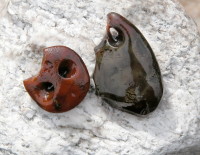
The biggest archaeological excavation in Norway ever
is now completed this year. This excavation would never been started if
there were not plans for carrying out the second biggest single industrial
project in Norway.
Photo.
Button and a jewellery of Amber. Copyright: Museum of Natural
History and Archaeology (Vitenskapsmuseet), Norway.
Jostein Gundersen, who is the
editor at the
Museum of Natural History and Archaeology (Vitenskapsmuseet),
Trondheim in
Norway, says
to Travel Explorations (18 August 2004) that it's too
early to say something about what the finds from Aukra means. At the time they
are going through the finds, classifying and analysing, examine nature
scientific samples etc.
According to him, it's a big puzzle that has to be worked out. They have of course
already achieved much knowledge already, but it's too early to be specific about the results
now. The continuing research work is estimated to take 2 years, but they will start to
publish information and results on their website during the autumn.
Some information is already
revealed about some of the finds.
So far
archaeologists have been found remains of stone axes, flint and slate artefacts
(example slate arrowheads and spearheads), jewelleries, fireplaces, graves,
fragments of human bones and sculls.
|
Photo. Stone
axe found the area.
Copyright: Museum of Natural History and Archaeology
(Vitenskapsmuseet), Norway. |
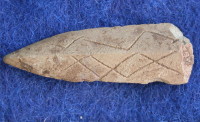 |
Amber (showed
on the photo on below), which is also called Scandinavia's Gold, was a valuable
and much sought-after material used in jewellery, figures and the like
throughout prehistory as well as in historic times themselves. Even though amber
is often described as a precious stone, it is in actual fact an organic product.
Amber is formed when a tree is damaged and resin seeps out to protect the
exposed wood. Under certain conditions, in the course of at least 20 million
years, the resin is transformed to amber as the plant fluid is transformed and
the oil content is reduced.
|
Photo. Button and a jewellery of Amber.
Copyright:
Museum of Natural History and Archaeology (Vitenskapsmuseet),
Norway. |
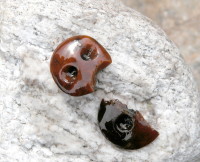 |
Amber is
not a product that is native to
Norway.
Therefore the amber found at Grynnvika probably originates from the
Baltic Sea region that stretches from the Baltic coast in the East to the coast
of Denmark in
the West. During the Stone-age, amber was a precious material, so the buttons
that were recovered have probably adorned the robes of a person with high status
at important events such as festivals or ritual-ceremonies. One interesting
parallel to the Grynnvika Amber is the discovery of 40 similar buttons at
Skatestraumen at Bremanger. These were found in a Middle-Neolithic context that
has been interpreted as a burial.
|
Photo. Grave chamber with stone circle in the middle.
Copyright:
Museum of Natural History and Archaeology (Vitenskapsmuseet),
Norway. |
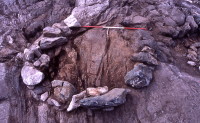 |
Archaeologists
have estimated that there are more than 1,6 million stone objects under ground.
So it will take a time to excavate the area totally, but so far they have a lot
of interesting finds to examine.
Finds from the middle of
the Late Stone-age
Field-supervisor
Heming Hagen has done post-excavation work which has consisted, among other
things of the washing and classifying some several thousand lithic artefacts.
Heming reports that the particularly elegant material points to an exciting site
from the middle of the Late Stone-age. The finds includes flint and slate
artefacts however 10 amber fragments stand out amongst this material.
In the middle of
the Late Stone-age (3300-2300 BC) there were increased contacts between
Western Norway and other regions to the South and East. An illustrative example of
such cultural-contacts between the coast of Møre and the Southern-Baltic
region was discovered at site 63 or Lille Grynnvika here at Gossen during the
winter. The discovery consists of 10 beautiful amber fragments. These were found
in or around a series of characteristic stone rows consisting of fire-cracked
stones and rosettes' overlain with slabs. These structures have
now been dated to the Middle-Neolithic period.
|
Photo. Fragment of a part of the lower jawbone: the chin-bone of a
child that was probably between two to four years old when he/she
died.
Copyright:
Museum of Natural History and Archaeology (Vitenskapsmuseet),
Norway. |
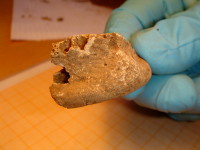 |
Graves from the
Stone-age are extremely rare in Norway. Form
the Early Stone-age, there are only 5 previous finds of human-bone. From the
Late Stone-age, there are more finds of this sort, but a clear child-grave like
this is not amongst this material.
It will be interesting to
find more about the past in Norway. Will these finds set the Norwegian oldest history in a
new light? People who are interested in this part of the history have to be
patient to wait for the results from the ongoing research work. Perhaps the
Norwegian oldest history has to be rewritten? One thing is sure: these finds
will be a real great tourist attraction when they will be
displayed!
Stein Morten Lund,
18 August
2004
Additional
information
For more
information, read about the excavation on the
Museum of
Natural
History and Archaeology's
(Vitenskapsmuseet) website www.vitenskapsmuseet.no/ormen (here you find
an English version too). It's also possible to view
pictures of a selection of the finds from the excavations at Nyhamna and other
places. You can find links here to other excavations in
Norway too.
The Norwegian
Directorate for Cultural Heritage (Riksantikvaren - www.riksantikvaren.no/english):
Protection under
Cultural Heritage Act: The purpose of cultural heritage management is described
in the Cultural Heritage Act, which lays down that it is a national
responsibility to safeguard archaeological and architectural monuments and sites
and cultural environments "as part of our cultural heritage and identity and as
an element in the overall environment and resource management". Riksantikvaren
(in Norwegian language - main site): www.ra.no
The UNESCO World
Heritage List contains areas or objects that are an irreplaceable part of the
world's cultural or natural heritage. The World Heritage Convention adopted as
its aim in 1972 to give special protection to places that because of their
universal value must be regarded as part of the world heritage for future
generations.
Norway ratified the convention in 1977, and
has the following four sites on the list:
- The
Mining
Town of Røros
- Bryggen in
Bergen
- The Rock
Carvings at Alta
-
Urnes
Stave Church
Norway member of the UNESCO Committee:
Norway has
been elected as a member of the World Heritage Committee. The Convention
Concerning the Protection of the World Cultural and Natural Heritage (the World
Heritage Convention) was adopted by the General Conference of UNESCO in 1972. To
date, more than 170 countries have adhered to the Convention. Nils Marstein,
Director General of the Norwegian Directorate for Cultural Heritage since 1995,
will represent Norway in
the Committee.
The Ormen
Lange project:
orsk Hydros
subsea solutions are taking technological developments on
the Norwegian continental shelf a significant step ahead. Nothing will be
visible on the surface when the enormous gas field Ormen
Lange comes onstream in 2007. The field will be developed with seabed
installations at depths of between 800 and 1100 metres, and will be linked to a
processing plant on land at Nyhamna in Aukra municipality, from where the gas
will be exported. When it reaches full production, the field will meet 20
percent of the UK demand
for gas.
The Ormen Lange
field is located in the Norwegian
Sea, 100 kilometres
north
west of the coast of
Møre,
Mid-Norway. It is Norway's
largest gas field, and was proven through drilling by Norsk Hydro in 1997. At
most there will be up to 2,500 people involved in the development of the
processing plant. This is twice the population of Gossen, in the
municipality of
Aukra. For more
information click on the link: www.ormenlange.com/en
